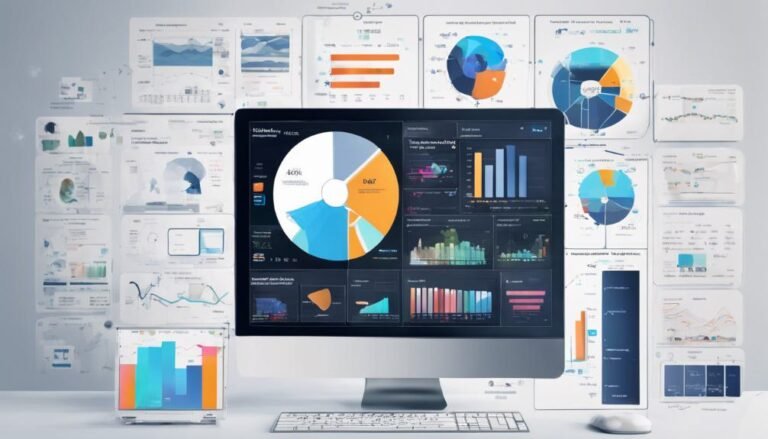AI in Cybersecurity for Financial Services
As you navigate the intricate landscape of cybersecurity within financial services, the integration of AI emerges as a beacon of innovation and efficiency. While AI has undeniably transformed risk assessment and threat detection in this sector, the domain of possibilities it offers is far-reaching. With AI's ability to adapt, learn, and predict, the question arises: What are the implications of this technology for the future of financial security and compliance?
Key Takeaways
- AI enhances risk assessment in financial services.
- Machine learning models adapt for compliance.
- AI-powered solutions detect threats effectively.
- Behavioral analytics improve fraud detection.
- AI encryption and analytics enhance data protection.
Growing Importance of AI in Cybersecurity
AI is increasingly playing an important role in enhancing cybersecurity measures within the financial services sector. When it comes to risk assessment, AI algorithms are revolutionizing the way financial institutions evaluate and manage potential threats.
By utilizing vast amounts of data, AI can quickly identify patterns and anomalies, providing more accurate risk assessments in real-time. Machine learning, a subset of AI, is also being leveraged for compliance purposes. These sophisticated algorithms can sift through regulatory requirements and vast amounts of legal text to make sure that financial institutions are meeting all necessary guidelines.
Through continuous learning, machine learning models can adapt to new regulations and updates, helping organizations stay compliant in an ever-changing landscape. Implementing AI in risk assessment and compliance not only enhances security but also improves efficiency and accuracy, ultimately leading to better protection against cyber threats for financial institutions.
AI-Powered Threat Detection Solutions
With the evolution of cybersecurity threats becoming more sophisticated, financial institutions are increasingly turning to AI-powered solutions for threat detection. Behavioral analytics plays a vital role in these solutions by monitoring user activities, patterns, and anomalies to identify potential threats.
Machine learning classifiers are then utilized to analyze vast amounts of data and detect suspicious behavior that traditional rule-based systems might miss. These AI-powered threat detection solutions can adapt and learn from new data, constantly improving their ability to identify and respond to emerging threats in real-time.
By leveraging machine learning classifiers, these systems can distinguish between normal and abnormal behaviors, enabling early detection of potential security breaches. Financial institutions are finding these AI-powered solutions indispensable in combating the growing complexity of cyber threats.
The combination of behavioral analytics and machine learning classifiers offers a proactive approach to threat detection, enhancing the overall security posture of financial services organizations.
Enhancing Fraud Detection With AI
Behavioral analytics and machine learning algorithms can greatly enhance fraud detection capabilities within financial institutions. Machine learning plays a vital role in analyzing vast amounts of data to identify patterns and anomalies that may indicate fraudulent activities. By continuously learning from new data inputs, machine learning models can adapt and improve their accuracy in detecting fraudulent behavior.
One key application of machine learning in fraud detection is in risk assessment. Machine learning algorithms can assess the risk associated with each transaction or account based on various factors such as transaction history, location, and amount. By assigning a risk score to each transaction, financial institutions can prioritize high-risk activities for further investigation, thereby enhancing their fraud detection efforts.
Incorporating machine learning into fraud detection systems allows financial institutions to stay ahead of increasingly sophisticated fraudsters. By leveraging advanced algorithms and behavioral analytics, organizations can proactively identify and prevent fraudulent activities, ultimately safeguarding their assets and maintaining trust with their customers.
Leveraging AI for Data Protection
Utilizing advanced machine learning models and encryption techniques is crucial for enhancing data protection measures in the domain of cybersecurity for financial services. AI encryption plays a pivotal role in safeguarding sensitive information by guaranteeing that data is securely stored and transmitted. By employing AI-driven encryption algorithms, financial institutions can mitigate the risk of unauthorized access and data breaches.
Behavioral analytics, another key component in data protection, focuses on monitoring and analyzing user behavior patterns to detect any anomalies or suspicious activities. Through the use of AI-powered behavioral analytics tools, financial organizations can establish baseline behaviors for users and swiftly identify deviations that may indicate a potential security threat. This proactive approach enables timely intervention and response to mitigate risks effectively.
Incorporating AI encryption and behavioral analytics into data protection strategies not only enhances the overall security posture of financial institutions but also ensures compliance with regulatory requirements and builds trust among customers regarding the safety of their sensitive data.
AI in Real-time Security Monitoring
AI plays a significant role in real-time security monitoring by continuously analyzing vast amounts of data to detect and respond to potential threats swiftly. Through the integration of real-time analytics and machine learning algorithms, AI systems can monitor network traffic, user behaviors, and system logs in real-time.
Real-time analytics enable AI to process incoming data instantly, identifying patterns indicative of cyber threats such as unusual login attempts, data exfiltration, or malware activity.
Machine learning algorithms enhance the capabilities of AI in real-time security monitoring by enabling systems to learn from historical data and adapt to new attack vectors. These algorithms can detect anomalies in network traffic or user behavior that may indicate a security breach.
By continuously updating their models based on new data, AI-powered security systems can improve their threat detection accuracy over time.
In essence, the combination of real-time analytics and machine learning algorithms empowers AI to provide proactive and adaptive security measures, enabling financial institutions to respond rapidly to emerging cyber threats and protect sensitive data effectively.
Future Trends in AI Cybersecurity
The evolution of cybersecurity landscape is paving the way for cutting-edge advancements in utilizing artificial intelligence to fortify the defense mechanisms against cyber threats.
Future trends in AI cybersecurity are heavily leaning towards AI-driven predictive analytics and the enhancement of machine learning algorithms.
AI-driven predictive analytics is set to revolutionize how cybersecurity measures are implemented. By leveraging vast amounts of data, AI can predict potential threats before they occur, enabling organizations to proactively strengthen their security posture. This proactive approach minimizes the likelihood of successful cyber attacks.
Furthermore, the continuous improvement of machine learning algorithms is reshaping the cybersecurity landscape. These algorithms can adapt and learn from new data patterns, allowing for more accurate threat detection and efficient response mechanisms. The integration of machine learning algorithms into cybersecurity practices enables systems to evolve and stay ahead of rapidly evolving cyber threats.
Conclusion
As you navigate the complex landscape of cybersecurity in financial services, remember: 'An ounce of prevention is worth a pound of cure.'
Embrace the power of AI to proactively identify and mitigate security risks, enhance fraud detection, and guarantee data protection.
By leveraging cutting-edge AI technologies for real-time security monitoring, financial institutions can stay ahead of cyber threats and safeguard their assets.
Stay vigilant, stay secure, and stay one step ahead with AI in cybersecurity.







